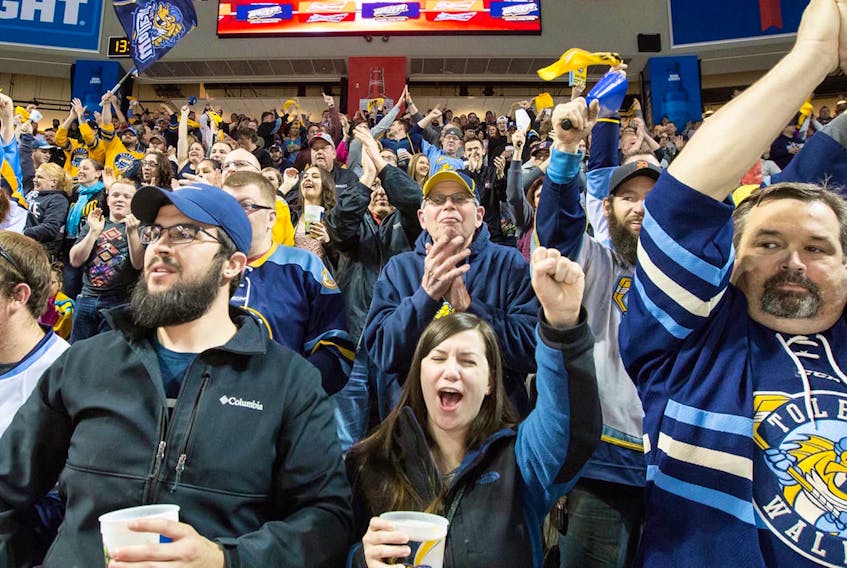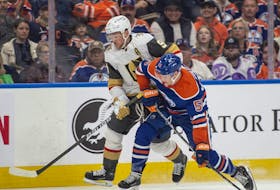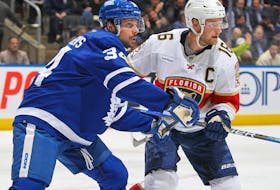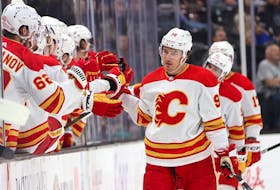ST. JOHN'S, N.L. — In 1999, there was some idea of a professional hockey team from St. John’s travelling to Toledo, Ohio to play a game there.
It took 20 years, but that will finally happen tonight as the Newfoundland Growlers face the homestanding Toledo Walleye in Game 3 of the ECHL Kelly Cup final.
The Growlers lead the best-of-seven series 2-0 after a pair of overtime wins last weekend at Mile One Centre in St. John’s. Because of the travel distance involved, Games 3, 4 and 5, the latter carrying the “if necessary” label, are set for Toledo’s Huntington Center, beginning with tonight’s contest (8:30 p.m. NT).
Toledo has been home to pro hockey for more than 70 years, stretching back to the days of the old International Hockey League, where the “Glass City” was represented by teams nicknamed Mercurys, Blades, Hornets and Goaldiggers. Minor-league coaching legend Ted Garvin guided the latter team during the late 1970s, when one of his players was a Boston College alum named Mike Eruzione, who would go onto fame as the Miracle On Ice hero for the United States at the 1980 Winter Olympics.
Since 1991, Toledo has been a member of the ECHL, first as the Storm. After a two-year voluntary suspension (2007-2009) while awaiting construction of a new rink, the team returned as the Walleye.
Toledo has never been a member of the American Hockey League, although for a while in 1999, it looked like the city would be joining the AHL, which at that time included the St. John’s Maple Leafs. There were plans for a 12,000-seat arena in Rossford, a suburb of Toledo, and the NHL's Detroit Red Wings seemed anxious to have their top farm team there, less than an hour from Detroit.

The Red Wings went so far as to end their longtime AHL hookup with Adirondack (Glens Falls, N.Y.), but the Rossford rink plan didn’t materialize, with Detroit instead eventually making the Grand Rapids Griffins its top farm club.
The collapse of the Red Wings-Rossford deal didn’t signal the end of professional hockey in Toledo. The ECHL’s Storm continued to operate until 2007, mostly bringing in 4,000 or better fans per game, but by that time, the team’s home, the Toledo Sport Arena, was 60 years old and in need of a replacement. Hence the two-year hiatus while the Lucas County Arena (later the Huntington Center) was constructed downtown. The restarted team was rebranded the Walleye — named after the region’s noted game fish, one that sometimes known in Canada as pike or pickerel — and has had great success, continually averaging 6,000 or more fans per season.
And things keep getting better. Average crowds for Walleye home games have grown for six straight years, from 6,022 in 2013-14 to 7,783 this past season, second-best in the 27-team ECHL, just behind the Fort Wayne Komets.
What’s even more impressive is that the seating capacity at the Toledo facility is about 7,400. That means almost every game is a seated sellout, with hundreds more buying standing room ticket.
That’s extended to the ECHL playoffs this spring, where the Walleye are averaging a league-topping 7,113 fans. On Monday, for example, only a couple of hundred standing-room tickets for tonight’s game against the Growlers, while Games 4 and 5 Friday and Saturday were already sold out.
The size of those Huntingdon Center crowds can make for a tough atmosphere for visitors, but have helped make Toledo an easy choice for those players considering ECHL employment. The Walleye are affiliated with the NHL’s Red Wings and AHL’s Grand Rapids Griffins, with about a third of their roster supplied by those teams, goaltender Pat Nagle being an example.
However, the core of the Toledo lineup consists of ECHL-contracted players, many of them veterans like team captain Shane Berschbach, a fifth-year Walleye; playoff leading scorer Greg Wolfe; and defenceman Matt Register, who amazingly is seeking a fourth straight Kelly Cup, having won league titles with the Allen Americans in 2016 and the Colorado Eagles the past two seasons.
The Walleye’s recent string of on-ice success — they were first in the ECHL’s Central Division for four straight years before a second-place division finish and run to the finals in 2019 — certainly had to be attractive to players seeking a championship, but so had to be Toledo’s reputation as a sports town. This past December, Livability.com named Toledo the No. 1 minor-league city in the United States, while the city (275,000 population, more than 600,000 metro), is annually ranked high in the same category by the Sports Business Journal.
The Walleye are big contributors to that, as are the minor-league baseball’s Toledo Mud Hens, who pack 9,000-seat Fifth Third Field, just a couple of blocks from the Walleye’s rink.
(If you just had a flash of remembrance of the TV sitcom M*A*S*H, it’s probably because you recall Corporal Max Klinger wearing a Mud Hens jersey. That’s because both the fictional Klinger and Jamie Farr, the actor who played him, are from Toledo.)
By the way, Fifth Third Field has played a role in the Walleye’s playoff march. Over the weekend, the baseball facility was the site for watch parties for hockey fans to take in streaming coverage of the opening games of the Kelly Cup final at Mile One. An estimated 2,500 showed up to watch Sunday’s Game 2.
Twitter: @TelyBrendan
RELATED









